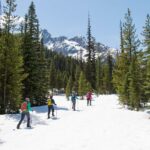As a snowmobile enthusiast, you already know the thrill of barreling down snow-covered trails, the cool rush of winter air with every twist and turn. But, have you wondered when those thrilling trails actually close? It’s essential to know not just for planning purposes, but also for safety reasons. Your passion comes with responsibilities, including adhering to these seasonal closures and understanding their direct impact on the environment and the sport you love so much. So, let’s talk about when exactly snowmobile trails close.
Understanding Snowmobile Trail Seasons
Snowmobile trail seasons refer to the designated period during which snowmobile trails are open and accessible for riding. The timeline for these seasons varies widely based on a host of factors, including geographical location, local regulations, and weather.
Definition of Snowmobile Trail Seasons
A snowmobile trail season specifically denotes the time window when trails are officially open for snowmobile use. This cycle typically coincides with the colder months, which ideally provide a sustainable layer of snow for the sport. Trail seasons are meticulously planned and monitored to ensure safe and convenient snowmobiling experiences.
Factors determining trail seasons
In determining snowmobile trail seasons, various factors come into play. These include but are not limited to, the region’s weather patterns, particularly its snowfall levels, landowner permissions, and local wildlife activity. Regulations enforced by local and national agencies also significantly influence the scheduling of trail seasons.
Importance of Knowing Trail Closure Dates
Being aware of trail closure dates is crucial for a myriad of reasons pertaining to respect for private property, personal safety, trail preservation, and more.
Respecting landowners and their property
A significant portion of snowmobile trails traverse private property, with landowners generously granting recreational use out of goodwill. Adhering to trail closure dates maintains this harmonious relationship between landowners and snowmobilers, demonstrating respect for personal property and proprietary rights.
Ensuring safety for betters and snowmobilers
Safety is paramount when it comes to snowmobiling. Trails are closed when conditions are deemed unsafe, either due to terrain issues, inadequate or inconsistent snow coverage, or impending weather conditions. Knowing closure dates helps prevent accidents and protects everyone involved.
Preventing damage to trails
Equally, the importance lies in preserving the trails themselves. Continuous snowmobile use can wear down trails, negatively impacting their longevity. Respecting closure dates gives nature time to recover, allowing snow and vegetation to replenish themselves.
Differences in Snowmobile Trail Closing Dates
Trail closing dates vary greatly, influenced by geographical location, snowfall levels, and increasingly, climate change.
Variation by geographic location
The geographical location of a trail significantly determines its closing date. In regions where winter conditions persist for longer, trails may remain open well into spring. Conversely, in areas with milder winter climes, trail seasons may conclude much earlier.
Variation due to climate change
Climate change is profoundly influencing snowmobile trail seasons. As unpredictable weather patterns become the norm, traditional trail seasons are changing, often leading to earlier closures due to premature thaws or insufficient snowfall.
Impact of weather conditions, specifically snowfall
It goes without saying that snowfall significantly impacts trail closure dates. Trails can remain open for longer during seasons with abundant snowfall. In contrast, a lack of or inconsistent snowfall often leads to early trail closures.
Early Season Snowmobile Trail Closures
Early season snowmobile trail closures are generally dictated by insufficient snowfall, warm temperatures, and trail grooming necessities.
Impact of insufficient snowfall
Without adequate snow cover, trails are exposed and prone to damage from snowmobiles. Additionally, lack of snow increases the risk of accidents and thus, trails may have to be closed early.
Effects of warm temperatures
Warm temperatures pose another challenge. They can cause rapid snowmelt, resulting in waterlogged trails. This not only makes the trails impassable but also could lead to significant terrain damage.
Role of trail grooming in trail closures
Trail grooming, which involves preparing and maintaining the trails for safe and enjoyable use, is crucial. If a trail can’t be appropriately groomed due to unfavourable weather conditions, it may necessitate an early closure.
Late Season Snowmobile Trail Closures
Late season trail closures are a regular occurrence in the world of snowmobiling, impacted by certain determining factors and unique challenges.
Determining factors for late season closures
Late season closures typically occur when the warmer spring weather arrives, leading to a snow meltdown. Wildlife activity, like the start of nesting season for birds, can also influence these closures.
Effects of spring thaw on snowmobile trails
Spring thaw essentially signals the end for snowmobile trails. As the snow melts, it can lead to waterlogged and muddy trails, making them unsafe and impassable for snowmobilers.
Challenges of late season snowmobiling
Late season snowmobiling also presents its challenges. Snow conditions can be unpredictable, and the quality may deteriorate, causing difficulties for riders. As a result, it’s often safer to close the trails by this stage.
Regulatory Guidelines for Snowmobile Trail Closures
Trail closures are also subject to certain regulations, local ordinances and penalties for non-compliance.
Government regulations
Various government regulations dictate when and how trails may be closed. These regulations can differ from state to state or country to country, but all aim to protect both snowmobilers and the environments they ride in.
Local bylaws and ordinances
In addition to broader government regulations, local bylaws and ordinances may also dictate trail closures. These may be influenced by a variety of factors, such as local wildlife activity, landowner preferences, or community-specific guidelines.
Penalties for non-compliance
There are penalties in place for those who choose to flout trail closure guidelines. Depending on the specific law or regulation broken, these can range from fines to serious legal consequences.
Finding Information on Snowmobile Trail Closures
There are a wealth of resources available to help you stay updated on trail closures, ranging from websites, local snowmobile clubs, and government offices.
Websites and online resources
In the digital age, keeping up-to-date with trail closure information has never been simpler. A wealth of online resources, including national and local park websites, offer updated information on trail conditions and closure dates.
Local snowmobile clubs
Enlisting with local snowmobile clubs provides a great way to keep abreast of trail closures. These organisations are usually manned by fellow enthusiasts who have a keen eye on the local weather conditions and are often the first to know about impending closures.
Local governmental offices
Local governmental offices like state park offices, department of natural resources offices, and local ranger stations also provide accurate and timely information about trail closings.
Maintaining Snowmobile Trails Post Closure
Post-closure trail maintenance is essential for the trail’s longevity and integrity, often led by snowmobile clubs and volunteers.
Role of snowmobile clubs
In many regions, snowmobile clubs handle the majority of trail maintenance work. This includes everything from clearing debris, repairing damage from the season, to prepping the trail for the next season.
Need for volunteers
These clubs are often dependent on volunteers who donate their time and energy to preserve these treasured routes. Through volunteering, individuals can contribute to keeping their beloved trails in top condition for seasons to come.
Off-season repairs and preparation for the next season
Off-season trail maintenance is a time of critical rest and vital repairs to ensure a smooth and safe ride when the season returns. This can include regrading the path, repairing any erosion, removing fallen trees, or even re-routing parts of the trail.
Snowmobiling Etiquette Regarding Trail Closures
Last but not least, to sustain snowmobile trail ethics and etiquette regarding trail closures needs to be observed.
Respecting trail closure signs
Being mindful of trail closure signs is a fundamental part of snowmobiling etiquette. These signs are placed for valid reasons, often related to safety or preservation efforts, and should never be ignored.
Understanding the reasons for closure
As a snowmobiler, understanding the reasons behind a trail’s closure is imperative. Whether for safety reasons, conservation efforts, or a landowner request, it’s always crucial to respect the closure decision.
Recognizing the shared responsibility in maintaining trails and adhering to closures is essential to the snowmobiling community. By respecting closure dates and rules, snowmobilers contribute to the preservation of trails and promote responsible outdoor recreation.
The Future of Snowmobile Trail Closures
Looking ahead, trail closures will continue to be a crucial aspect of snowmobiling, affected by factors such as climate change, advancements in technology, and potential policy changes.
Climate change and its impact
Climate change stands as a potent influence over snowmobile trail closures. As weather patterns shift and become less predictable, the usual trail seasons may likewise adjust, potentially leading to more frequent closures.
Innovative technologies in trail maintenance
Technological advancements could also play a part in the future of trail maintenance. Innovations such as automated grooming machines or high-tech snow monitoring systems could enhance trail preservation efforts, reducing the need for some closures.
Policy changes and future considerations
As we continue to learn more about the effects of outdoor recreation on the environment, policy changes are a strong possibility. Future legislation could yet introduce new procedures and protocols around trail closure, all in the pursuit of shaping a more sustainable, environmentally conscious snowmobiling culture.
- What Snowboard Bindings Should I Get? - January 23, 2024
- What Size Screws For Snowboard Bindings? - January 23, 2024
- How To Snowmobile On Water? - January 23, 2024










